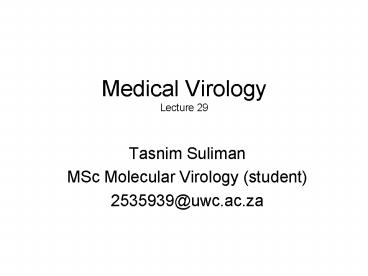Medical Virology Lecture 29 PowerPoint PPT Presentation
1 / 19
Title: Medical Virology Lecture 29
1
Medical VirologyLecture 29
- Tasnim Suliman
- MSc Molecular Virology (student)
- 2535939_at_uwc.ac.za
2
What are viruses?
- Small obligate intracellular parasites
- Virion
- Complete virus particle nucleic acid protein
coat, which may be surrounded by an envelope - It is the form in which the virus moves between
cells or hosts - Viral Genome
- EITHER RNA or DNA genome surrounded by a
protective virus-coded protein coat (Capsid) - Propagation depends on specialized host cells
supplying the machinery for replication,
metabolism and biosynthesis
3
- The DNA or RNA genome may be
- ss single stranded or
- ds double stranded
- Genomes may be either
- () sense Positive-sense viral RNA is identical
to viral mRNA and thus can be immediately
translated into protein by the host cell. - OR
- (-) sense Negative-sense viral RNA is
complementary to mRNA and thus must be converted
to positive-sense RNA by an RNA polymerase before
translation. - Retroviruses?
4
Definitions
- Bacteriophage
- Virus that infects prokaryotic (bacterial)
cells. - Nucleocapsid
- viral nucleic acid the protein coat that
encloses it. - Represents the packaged form of the viral genome.
5
Viral Structure - Overview
Spike protein
Fig 1. Schematic overview of the structure of
animal viruses does not exist in all viruses
6
Viral Structure
- Varies in size, shape and symmetry
- VIP for classification
- 3 types of capsid symmetry
- Cubic (icosahedral)
- Has 20 faces, each an equilateral triangle. Eg.
adenovirus - Helical
- Protein binds around DNA/RNA in a helical fashion
eg. Coronavirus - Complex
- Is neither cubic nor helical eg. poxvirus
7
http//micro.magnet.fsu.edu/cells/virus.html
8
Viral Structure
Figure 1 An array of viruses. (a) The helical
virus of rabies. (b) The segmented helical virus
of influenza. (c) A bacteriophage with an
icosahedral head and helical tail. (d) An
enveloped icosahedral herpes simplex virus. (e)
The unenveloped polio virus. (f) The icosahedral
HIV with spikes on its envelope.
9
(No Transcript)
10
Viral Replication
- When a virus infects a cell, nucleic acid must be
uncoated and gain access to metabolic machinery
of cell. - Virus life cycle is characterized by
- attachment
- penetration, with entry of nucleic acid into cell
- early expression of virus genes (either directly
by translation, if virus contains "" RNA, or
indirectly after transcription and then
translation) - replication of virus nucleic acid
- synthesis of new virion components
- packaging and assembly of new virions
- exit from cell
11
- Attachment
- specific binding of a virion protein (the
anti-receptor) to a constituent of the cell
surface (the receptor) - e.g. hemagglutinin of influenza virus
- some complex viruses (HSV) may have more than one
species of anti-receptor molecule - Penetration
- energy-dependent step
- occurs almost instantaneously after attachment
12
- After the virus attaches to the host cell, it can
enter the cell by several mechanisms - Transfer of the entire viral particle across the
cell membrane by endocytosis - Transfer of only the viral genome through the
cell membrane - Fusion of the viral envelope with the host cell
membrane
13
- Uncoating
- at same time as penetration or shortly after
- separation of viral nucleic acid (n.a.) from
outer structural components - Released as
- free n.a. (picornaviruses)
- as nucleocapsid (reoviruses) may need acidic pH
in endosome - viruses only infectious agent for which
dissolution of infecting agent obligatory step in
replicative pathway - Expression of viral genome and synthesis of viral
components
14
- After the viral nucleic acid is released inside
the host cell - The transcription and translation processes of
the host cell are redirected for the production
of viral proteins and nucleic acids - The different types of nucleic acid genomes are
expressed and replicated in several ways - DNA genomes undergo replication-using processes
similar to cellular replication - RNA genomes may be ssRNA Can be read directly
as an mRNA or reverse transcribed by reverse
transcriptase into DNA - RNA genomes may also be -ssRNA The RNA must
first be used as a template to form mRNAs
15
Assembly and Release
- Components of capsid synthesis directed by late
genes - Assembly of enveloped viruses needs interaction
with plasma membrane which has been modified - Final stage of infection
- Enveloped viruses released gradually by budding
or exocytosis - Naked viruses accumulate in cytoplasm and
released during lysis
16
(No Transcript)
17
(No Transcript)
18
Viroids Prions
- Viroids
- ss RNA genome and the smallest known pathogens.
- Affects plants
- Prions
- Infectious particles that are entirely protein.
- No nucleic acid
- Highly heat resistant
- Animal disease that affects nervous tissue
- Affects nervous tissue and results in
- Bovine spongiform encepahltits (BSE) mad cow
disease, - scrapie in sheep
- kuru Creutzfeld-Jakob Disease (CJD) in humans
19
For more info
- http//virology-online.com/general/Replication.htm
- http//www.hhmi.org/biointeractive/animations/infe
ction/inf_middle_frames.htm (animation)

